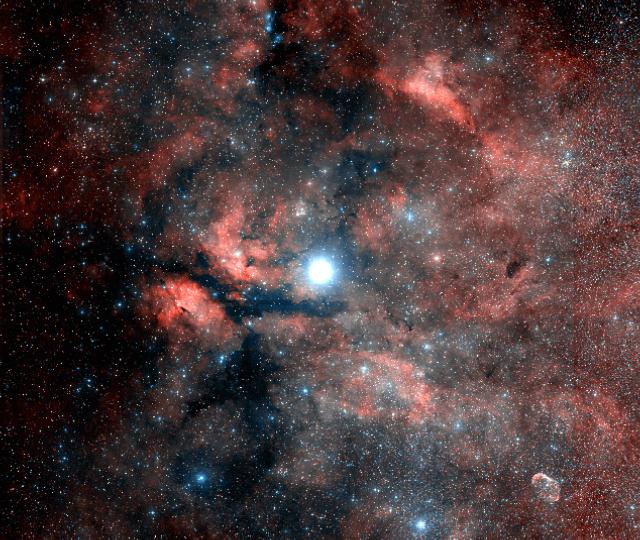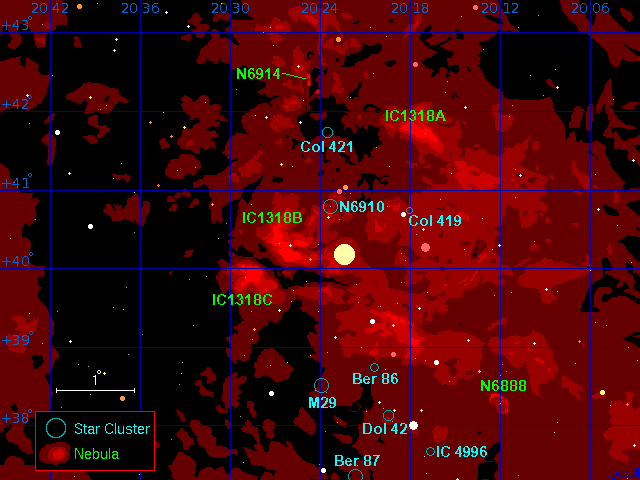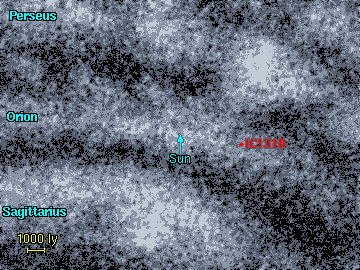
The Gamma Cygni Nebula. Image size: 5.6°x4.7°. DSS image. © CalTech/Palomar
The Gamma Cygni nebula consists of the various pink patches which can be seen surrounding Gamma Cygni - the bright star in the middle of this photograph. Gamma Cygni is actually not part of this nebula, it is a foreground star located half way between us and the nebula. We are looking deep into the Orion Arm of our Galaxy in this direction and the nebula is more than 3000 light years from us.

This is a list of the principal nebulae in this region. The Gamma Cygni nebula, IC 1318, has three bright patches (parts A, B and C,) and they each have a diameter of about 50 light years. The Crescent nebula (NGC 6888) consists of some shells of gas energised by a very energetic Wolf-Rayet star. NGC 6914 is a small reflection nebula in this region.
1 2 3 4 5 6 7 8
Catalogue Equatorial Galactic Size Type Distance Size Other Names
Number Coordinates Coordinates (arcmins) (ly) (ly)
RA (2000) Dec l° b°
---------------------------------------------------------------------------------------
NGC 6888 20 12.1 +38 21 75.5 +2.4 18' E 4100 20 Crescent nebula
IC 1318A 20 16.6 +41 49 78.8 +3.6 50' E 3700 55 Gamma Cygni nebula
NGC 6914 20 24.7 +42 29 80.2 +2.8 5' R 3700 5
IC 1318B 20 26.5 +40 18 78.7 +1.2 50' E 3700 55 Gamma Cygni nebula
IC 1318C 20 28.7 +39 54 78.6 +0.7 40' E 3700 45 Gamma Cygni nebula
|
Column 1: The standard catalogue name for the nebula. Column 2: Right Ascension and Declination for epoch 2000. Column 3: Galactic Longitude (l) and Latitude (b). Column 4: Angular size of the nebula in arcminutes. Column 5: Nebula type: E = emission, R = reflection. Column 6: Approximate distance to the nebula. Column 7: Approximate size of the nebula in light years. Column 8: Alternative name of the nebula.
These are the star clusters which are most closely associated with the Gamma Cygni nebula. NGC 6910 and M29 (NGC 6913) are the two brightest star clusters in this region, and both of these star clusters formed in this nebula.
1 2 3 4 5 6 7
Catalogue Equatorial Galactic Size Distance Age Other Names
Name Coordinates Coordinates (arcmins) (ly) (million
RA (2000) Dec l° b° years)
----------------------------------------------------------------------------------
IC 4996 20 16.5 +37 38 75.4 +1.3 6' 5650 9
Collinder 419 20 18.1 +40 43 78.1 +2.8 4' ? ?
Dolidze 42 20 19.8 +38 08 76.1 +1.1 7' 3150 35
Berkeley 86 20 20.5 +38 42 76.7 +1.3 6' 3650 13
Berkeley 87 20 21.8 +37 22 75.7 +0.3 10' 2050 14
NGC 6910 20 23.3 +40 47 78.7 +2.0 10' 3700 13
Collinder 421 20 23.4 +41 42 79.5 +2.5 7' ? ?
NGC 6913 20 24.0 +38 31 76.9 +0.6 10' 3750 13 M29
|
Column 1: The standard catalogue name for the cluster.
Column 2: Right Ascension and Declination for epoch 2000.
Column 3: Galactic Longitude (l) and Latitude (b).
Column 4: Angular size of the cluster in arcminutes.
Column 5: Distance to the cluster.
Column 6: Approximate age of the cluster in millions of years.
Column 7: Alternative name of the cluster.
References: Dias W, Alessi B, Moitinho A, Lépine J, (2002). New catalogue of optically
visible open clusters and candidates. Astron and Astrophys, 389, 871.
This is a map of the star clusters and nebulae in this region. There are a lot of nebulae (bright and dark) in this part of the sky because we are looking deep into our Galaxy in this direction. The region from IC 1318A to IC 1318C extends across 200 light years of space. The relatively dark region in the top-left area of this map is sometimes known as the Northern Coalsack (Barnard 348).


|
The Gamma Cygni nebula is located in the Orion Arm of the Galaxy. If we assume that the two brightest star clusters in this region belong to this nebula then the distance to the Gamma Cygni nebula is about 3700 light years. |
The Crescent Nebula is a famous nebula in this region. The nebula consists of shells of gas that are being energized by the strong stellar wind from the Wolf-Rayet star WR 136, the bright star at the center of the nebula. Wolf-Rayet stars are very hot, massive stars that are blowing off their outer layers. The nebula has a length of about 20 light years.
